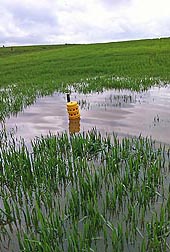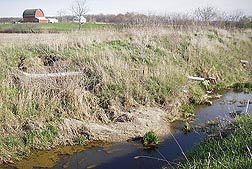Delaying Drainage From Prairie
Potholes Protects Water Quality
Midwest prairies are some of the most productive farmlands in the United States, and prairie potholes—depressions left behind in the landscape when glaciers made their last retreat around 12,000 years ago—contain some of the prairies’ most fertile soils. The potholes are prone to ponding because they have no natural drainage outlet, so farmers often install tile risers to drain away excess water. These risers, which are vertical perforated pipes that extend a foot or more above the soil, also connect directly to subsurface tile drainage networks that are spread throughout the Midwest.
“For farmers, the advantage with risers is that water drains quickly,” says Agricultural Research Service soil scientist Doug Smith, who works at the ARS National Soil Erosion Research Laboratory in West Lafayette, Indiana. “But they don’t like having to drive around the risers or having to make sure they don’t hit them with field equipment. And the risers are hard to see when the crop is up.”
The tile risers are also a key component of a serious long-term—and widespread—environmental issue. Water drained from potholes by the risers is discharged via the subsurface drains into the nearest field ditch without any filtration or processing to remove excess phosphorus, nitrogen, or sediment. In these landscapes, Smith says, field ditches function as first-order streams. So there’s a good chance the agricultural pollutants drained from the potholes in the St. Joseph River watershed in northeast Indiana will eventually reach Lake Erie and help nourish algal blooms that can turn the water a disconcerting shade of shamrock green.
Scientists earlier identified the connections between water from artificially drained potholes, nutrient loading, and water quality as part of research for the Conservation Effects Assessment Project, a nationwide effort to evaluate the effectiveness of conservation practices in improving water quality. Since 2002, Smith and others working in the St. Joseph River basin have identified direct correlations between the number and extent of artificially drained potholes in the watershed and nitrogen and phosphorus levels in nearby streams.
“We know that tile risers create water-quality issues throughout the Lake Erie Watershed, which includes the St. Joseph River Watershed,” Smith says. “Now we must find out how to manage the problem.”
Smith and West Lafayette soil scientist Stan Livingston conducted two studies to assess methods for reducing the transport of nutrient loads from prairie potholes. In the first study, a local farmer agreed to let the researchers set up tile risers and an alternative drainage system called a “blind inlet” in side-by-side potholes on a working crop field.
A blind inlet is similar to a French drain that channels excess water away from a building foundation. The scientists constructed their blind inlets by digging a square pit 3 feet deep at the lowest point of the pothole and then placing a layer of coarse limestone gravel in the bottom of the pit. Septic tile lines were placed on top of the gravel layer and covered with another layer of limestone gravel. The second layer of gravel was covered by landscape fabric, and the rest of the hole was backfilled with coarse soil to facilitate infiltration.
|
|
Smith and Livingston found that water samples that exited the potholes through the risers consistently showed the highest levels of total phosphorus lost from the fields—as high as 1.73 ounces per acre during one storm event. In addition, almost all samples drained by the risers had higher levels of sediment, soluble phosphorus, total phosphorus, and nitrogen.
Phosphorus loads in samples channeled through the blind inlets were, on average, 78 percent lower than those in samples channeled through tile risers, and average sediment loads were 79 percent lower. Smith also noted that discharge rates from the potholes drained by blind inlets were lower, in large part because the gravel layers slowed down the flow of water. But the slower drainage didn’t appear to damage the growing crops.
In the second study, in a 770-acre basin, Smith and Livingston replaced 13 tile risers with blind inlets. Then they compared sediment, phosphorus, and nitrogen loads in water samples collected from this basin to water samples collected from an adjacent 735-acre basin drained with tile risers.
The water samples were collected in the spring of 2010, when rainfall was significantly above average, so runoff levels from both basins were also much higher than usual. Compared to discharge in previous years, discharge in 2010 from the basin drained with tile risers increased 417 percent, and total phosphorus loading increased 737 percent. But in the basin drained with blind inlets, discharge only increased 64 percent, and total phosphorus loading only increased 92 percent.
“Blind inlets break the connectivity between pothole drainage and subsurface tiles,” Smith says. Breaking that connectivity has a number of benefits, starting with simply reducing the volume of water eventually drained from the potholes.
While the water slowly percolates from the pothole through layers of gravel and soil, its nutrient load is available for plant uptake or denitrification, which reduces the amount of phosphorus and nitrogen that eventually ends up in the nearest field ditch. Since blind inlets trap sediment more effectively than risers—which only filter out large organic debris like cornstalks—they also help reduce loads of insoluble phosphorus that are adsorbed onto particulate matter.
Because of Smith’s study, Indiana farmers who want to replace existing tile risers with blind inlets to improve water quality are eligible for financial assistance through the USDA Natural Resources Conservation Service’s Environmental Quality Incentives Program Water Quality Initiative. A paper describing the research and results has been published in Soil Use and Management.
“Our results were what we were hoping for,” Smith says. “We thought we’d see problems with tile risers, so we wanted to find something that we could use to treat the water-quality issues and that wouldn’t hurt crop production. So I consider this project a success.”—By Ann Perry, Agricultural Research Service Information Staff.
This research is part of Water Availability and Watershed Management, an ARS national program (#211) described at www.nps.ars.usda.gov.
Doug Smith is with the USDA-ARS National Soil Erosion Research Laboratory, 275 South Russell St., West Lafayette, IN 47907-2077; (765) 494-0330.
"Delaying Drainage From Prairie Potholes Protects Water Quality" was published in the October 2013 issue of Agricultural Research magazine.









